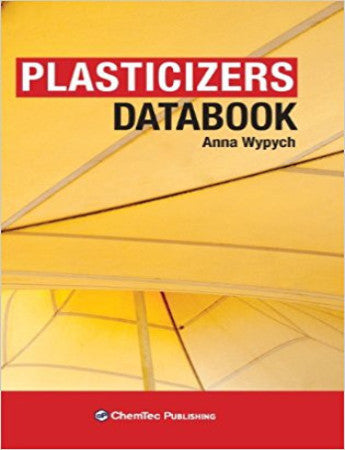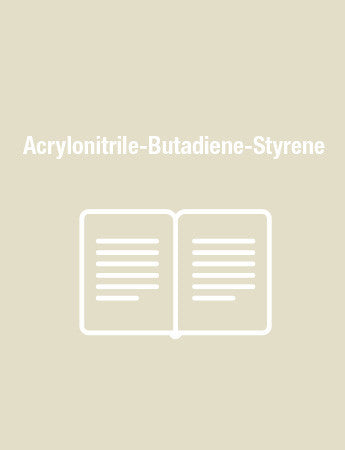Plasticizer Databook
Plasticizer Databook contains data on selection of the most important plasticizers in use today. The selection includes 375 generic and commercial plasticizers. The generic plasticizers contain data for the particular chemical compound from numerous sources and these generic plasticizer tables usually contain the most extensive information. The commercial plasticizers include only data given by plasticizer manufacturers. This allows comparison of properties of commercial plasticizers coming from different sources.
Plasticizer Databook was developed to contain data required in plasticizers application. Attempts were made to include plasticizers used in various sectors of industry to provide information for all users and to help in finding new solutions. Plasticizers included in the book differ from solvents by boiling point, which is above 250oC, but some plasticizers are used as temporary plasticizers or are expected to react with other components of the mixture. These substances will not meet the boiling temperature criterion but will still be included since they play the role of plasticizers.
The tables in the book are divided into five general sections: General information, Physical properties, Health & safety, Ecological properties, and Use & performance. Only available fields for particular plasticizer are included in the individual tables.
In General Information section the following data are displayed: name, CAS #, IUPAC name, Common name, Common synonyms, Acronym, Empirical Formula, Molecular mass, RTECS Number, Chemical Category, Mixture, EC number, Ester Content, Phosphorus Content, Bromine Content, Solids Content, Oxirane Oxygen Content, Paraffinic Content, Naphthenic Content, Moisture Content, Chlorine Content, Bound Acrylonitrile, Sulfur Content, Butadiene Content, Aromatic Carbon, Total Aromatic Content, and Hydroxyl Number.
Physical Properties section contains data on State, Odor, Color (Gardner, Saybolt, and Platinum-cobalt scales), Boiling point, Melting point, Freezing point, Pour point, Iodine Value, Refractive indices at different temperatures, Specific gravity at different temperatures, Density at different temperatures, Vapor pressure at different temperatures, Coefficients of Antoine equation, Temperature range of accuracy of Antoine equation, Vapor Density, Volume Resistivity, Acid number, Acidity(acetic acid), Saponification value, pH, Viscosity at different temperatures, Kinematic viscosity at different temperatures, Absolute viscosity at 25C, Surface tension at different temperatures, Solubility in water, and Water solubility.
Health & Safety data section contains data on NFPA Classification, Canadian WHMIS Classification, HMIS Personal Protection, OSHA Hazard Class, UN Risk Phrases, US Safety Phrases, UN/NA Class, DOT Class, ADR/RIC Class, ICAO/IATA Class, IMDG Class, Food Approval(s), Autoignition Temperature, Flash Point, Flash Point Method, Explosive LEL, Explosive UEL, TLV - TWA 8h (ACGIH, NIOSH, OSHA), Max Exposure Concentration NIOSH-IDLH, Toxicological Information, acute, Rat oral LD50, Mouse oral LD50, Rabbit dermal LD50, Dermal LD50 (guinea pig), LD50 dermal rat, Inhalation, LC50, (rat, mouse, 4h (mist)), Skin irritation, Eye irritation (human), Carcinogenicity, Teratogenicity, and Mutagenicity.
Ecological Properties section includes Biological Oxygen Demand, Chemical Oxygen Demand, Theoretical Oxygen Demand, Biodegradation probability, Aquatic toxicity LC50 (Rainbow trout, Bluegill sunfish, Sheepshead minnow, Fathead minnow, and Daphnia magna), and Partition coefficients (log Koc and log Kow).
Use & Performance section contains the following information: Manufacturer, Recommended for Polymers, Recommended for Products, Outstanding Properties, Limiting Oxygen Index, Tensile Strength at different concentrations of plasticizer, Ultimate Elongation at different concentrations of plasticizer, Elastic Elongation, 100% Modulus at different concentrations of plasticizer, Brittle Temperature at different concentrations of plasticizer, Low Temperature Flexibility at different concentrations of plasticizer, Clash-Berg at different concentrations of plasticizer, Shore A Hardness at different concentrations of plasticizer, and Volatility at different concentrations of plasticizer and different temperatures.
This book is an excellent companion to the Handbook of Plasticizers because data in the Plasticizer Databook do not repeat information or data included in the Handbook of Plasticizers.
Author
Anna Wypych, born in 1937, studied chemical engineering and polymer chemistry and obtained M. Sc. in chemical engineering in 1960. The professional expertise includes both teaching and research & development. Anna Wypych has published 1 book (MSDS Manual), several databases, 6 scientific papers, and obtained 3 patents. She specializes in polymer additives for PVC and other polymers and evaluates their effect on health and environment.
Plasticizer Databook was developed to contain data required in plasticizers application. Attempts were made to include plasticizers used in various sectors of industry to provide information for all users and to help in finding new solutions. Plasticizers included in the book differ from solvents by boiling point, which is above 250oC, but some plasticizers are used as temporary plasticizers or are expected to react with other components of the mixture. These substances will not meet the boiling temperature criterion but will still be included since they play the role of plasticizers.
The tables in the book are divided into five general sections: General information, Physical properties, Health & safety, Ecological properties, and Use & performance. Only available fields for particular plasticizer are included in the individual tables.
In General Information section the following data are displayed: name, CAS #, IUPAC name, Common name, Common synonyms, Acronym, Empirical Formula, Molecular mass, RTECS Number, Chemical Category, Mixture, EC number, Ester Content, Phosphorus Content, Bromine Content, Solids Content, Oxirane Oxygen Content, Paraffinic Content, Naphthenic Content, Moisture Content, Chlorine Content, Bound Acrylonitrile, Sulfur Content, Butadiene Content, Aromatic Carbon, Total Aromatic Content, and Hydroxyl Number.
Physical Properties section contains data on State, Odor, Color (Gardner, Saybolt, and Platinum-cobalt scales), Boiling point, Melting point, Freezing point, Pour point, Iodine Value, Refractive indices at different temperatures, Specific gravity at different temperatures, Density at different temperatures, Vapor pressure at different temperatures, Coefficients of Antoine equation, Temperature range of accuracy of Antoine equation, Vapor Density, Volume Resistivity, Acid number, Acidity(acetic acid), Saponification value, pH, Viscosity at different temperatures, Kinematic viscosity at different temperatures, Absolute viscosity at 25C, Surface tension at different temperatures, Solubility in water, and Water solubility.
Health & Safety data section contains data on NFPA Classification, Canadian WHMIS Classification, HMIS Personal Protection, OSHA Hazard Class, UN Risk Phrases, US Safety Phrases, UN/NA Class, DOT Class, ADR/RIC Class, ICAO/IATA Class, IMDG Class, Food Approval(s), Autoignition Temperature, Flash Point, Flash Point Method, Explosive LEL, Explosive UEL, TLV - TWA 8h (ACGIH, NIOSH, OSHA), Max Exposure Concentration NIOSH-IDLH, Toxicological Information, acute, Rat oral LD50, Mouse oral LD50, Rabbit dermal LD50, Dermal LD50 (guinea pig), LD50 dermal rat, Inhalation, LC50, (rat, mouse, 4h (mist)), Skin irritation, Eye irritation (human), Carcinogenicity, Teratogenicity, and Mutagenicity.
Ecological Properties section includes Biological Oxygen Demand, Chemical Oxygen Demand, Theoretical Oxygen Demand, Biodegradation probability, Aquatic toxicity LC50 (Rainbow trout, Bluegill sunfish, Sheepshead minnow, Fathead minnow, and Daphnia magna), and Partition coefficients (log Koc and log Kow).
Use & Performance section contains the following information: Manufacturer, Recommended for Polymers, Recommended for Products, Outstanding Properties, Limiting Oxygen Index, Tensile Strength at different concentrations of plasticizer, Ultimate Elongation at different concentrations of plasticizer, Elastic Elongation, 100% Modulus at different concentrations of plasticizer, Brittle Temperature at different concentrations of plasticizer, Low Temperature Flexibility at different concentrations of plasticizer, Clash-Berg at different concentrations of plasticizer, Shore A Hardness at different concentrations of plasticizer, and Volatility at different concentrations of plasticizer and different temperatures.
This book is an excellent companion to the Handbook of Plasticizers because data in the Plasticizer Databook do not repeat information or data included in the Handbook of Plasticizers.
Author
Anna Wypych, born in 1937, studied chemical engineering and polymer chemistry and obtained M. Sc. in chemical engineering in 1960. The professional expertise includes both teaching and research & development. Anna Wypych has published 1 book (MSDS Manual), several databases, 6 scientific papers, and obtained 3 patents. She specializes in polymer additives for PVC and other polymers and evaluates their effect on health and environment.
1 INTRODUCTION
2 INFORMATION ON DATA FIELDS
3 PLASTICIZERS
3.1 Abietates
3.2 Adipates
3.3 Alkyl sulfonates
3.4 Azelates
3.5 Benzoates
3.6 Bioplasticizers
3.7 Biodegradable plasticizers
3.8 Chlorinated paraffins
3.9 Citrates
3.10 Cyclohexane dicarboxylic acid, diisononyl ester
3.11 Energetic plasticizers
3.12 Epoxides
3.13 Glutarates
3.14 Glycols
3.15 Hydrocarbon oils
3.16 Isobutyrates
3.17 Maleates
3.18 Oleates
3.19 Pentaerythritol derivatives
3.20 Phosphates
3.21 Phthalate-free plasticizers
3.22 Phthalates
3.23 Polymeric plasticizers
3.24 Reactive plasticizers
3.25 Ricinoleates
3.26 Sebacates
3.27 Sulfonamides
3.27 Trimellitates
2 INFORMATION ON DATA FIELDS
3 PLASTICIZERS
3.1 Abietates
3.2 Adipates
3.3 Alkyl sulfonates
3.4 Azelates
3.5 Benzoates
3.6 Bioplasticizers
3.7 Biodegradable plasticizers
3.8 Chlorinated paraffins
3.9 Citrates
3.10 Cyclohexane dicarboxylic acid, diisononyl ester
3.11 Energetic plasticizers
3.12 Epoxides
3.13 Glutarates
3.14 Glycols
3.15 Hydrocarbon oils
3.16 Isobutyrates
3.17 Maleates
3.18 Oleates
3.19 Pentaerythritol derivatives
3.20 Phosphates
3.21 Phthalate-free plasticizers
3.22 Phthalates
3.23 Polymeric plasticizers
3.24 Reactive plasticizers
3.25 Ricinoleates
3.26 Sebacates
3.27 Sulfonamides
3.27 Trimellitates
Anna Wypych, born in 1937, studied chemical engineering and polymer chemistry and obtained M. Sc. in chemical engineering in 1960. The professional expertise includes both teaching and research & development. Anna Wypych has published 1 book (MSDS Manual), several databases, 6 scientific papers, and obtained 3 patents. She specializes in polymer additives for PVC and other polymers and evaluates their effect on health and environment.




